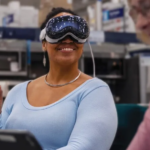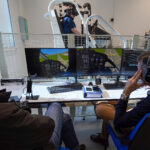Spatial computing is a powerful technology that fundamentally changes how we interact with digital environments and objects. Integrating virtual and physical worlds through augmented reality (AR), virtual reality (VR) and mixed reality (MR) devices creates a bridge that enables seamless, immersive interactions with 3D environments.
Working on a VR collaboration platform for a U.S.-based client gave us firsthand experience with multimodal AI grounded in human senses. We enabled real-time, multi-user collaboration by training the platform with visual (VR environments), spatial (user interactions) and textual (authentication) data.
Some key challenges we addressed included synchronizing multiplayer actions, handling user authentication in VR and streaming 360-degree Vimeo videos smoothly. Our technical solutions involved using the Photon Unity Engine for real-time synchronicity, Firebase for authentication and performance optimization for video streaming.
This hands-on experience with spatial computing showed us that when properly implemented, these immersive technologies significantly enhance team collaboration by creating shared virtual spaces that transcend the limitations of traditional 2D interfaces, a benefit I’ll explore further below.
Spatial Computing And The Birth Of A Disruptive Technology
At its core, spatial computing combines computer vision, depth sensing and motion tracking to create authentic interactions with digital content placed within cloud layers over the physical world. This technology has emerged as a transformative force across various sectors, including education, entertainment, healthcare and retail.
Launching high-powered hardware like the Apple Vision Pro allows spatial computing to enter the mainstream. This technology includes AR, VR and new types of devices that can provide an immersive interactive experience for users, which isn’t just an improvement in user experience but a radical shift in how we think of work.
Why 2D Tools Can’t Keep Up
Popular tools such as email, chat and video conferencing are built to function in a 2D world. Although these tools have done their job well in remote working environments, their flatness fails to enable the complexity and rich content necessary for high-level collaboration. For example, a video call may allow co-workers to see and hear each other, but it does not deliver the richness of interaction that an on-site partnership provides.
In addition, the flatness of 2D tools makes it challenging to express spatial information, such as where things are in physical space or the progress of a multifaceted project. For example, when team members work on 3D models or designing layouts, it’s simply impossible to understand the full context through a flat screen.
The Spatial Advantage
The transition from 2D to spatial computing brings unprecedented versatility. Digital elements can exist and be manipulated in 3D space, allowing apps to become more creative and functional in ways traditional software cannot match.
Spatial computing creates environments that feel real, allowing users to interact with digital objects as if they were physical. This transforms collaboration by replicating shared physical spaces for brainstorming, design reviews and project planning; enabling natural gestural manipulation of tools and data; and giving virtual meetings a tangible, physical presence that video calls cannot provide.
This interactive experience makes team members feel like they are in the same room, even though they may be thousands of miles apart.
3D Tools For Smarter Teamwork
As spatial computing evolves, teamwork becomes less about information sharing and more about experience sharing. Teams can collaborate in 3D, interacting with responsive tools in real time. For example, project management software can be enhanced with spatial capabilities, allowing teams to physically move 3D task cards or visualize project progress in three-dimensional space.
Improved spatial awareness can also help teams remain aligned and focused on goals and reduce potential miscommunication by adding more dimensions to remote interaction.
Collaboration With Spatial Computing
I believe spatial computing is the gateway to the future of remote work and collaboration. As businesses adopt more flexible work environments, this technology bridges the gap between virtual and physical collaboration experiences.
Companies facing the challenges of remote workforce engagement can move beyond the limitations of conventional video conferencing. Unlike two-dimensional video calls that miss the nuance of in-person interactions and can be mentally draining, spatial computing offers immersive, interactive spaces that better replicate face-to-face cooperation.
Business leaders should begin exploring this transformational technology now, as the future of collaboration is increasingly becoming immersive, interactive and spatial.
Quelle:
Foto: Getty


